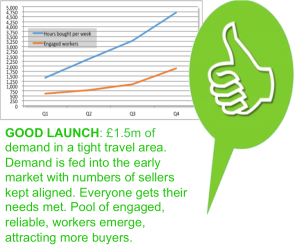 Demand and supply needs to be ready before a launch. This “Market Making” takes a mix of leadership and legwork.
Demand and supply needs to be ready before a launch. This “Market Making” takes a mix of leadership and legwork.
.
Why make a market?
If a strongly worker-centric labor platform is just turned on for a given city, it will be swamped by people needing better work. Demand for their labor will move more cautiously. We can see this in data from one of the London (UK) local governments that launched:
 Officials put the platform in their website, encouraging intermediaries to do the same, then approve workers. In week of launch there was 18,000 hours of resident availability….but 70 hours of bookings. The second week; bookings were up to 150 hours but availability was down to 12,000. Both trends continued until the market stabilized at about 500 hours of weekly bookings sustaining a pool of some 40 workers.
Officials put the platform in their website, encouraging intermediaries to do the same, then approve workers. In week of launch there was 18,000 hours of resident availability….but 70 hours of bookings. The second week; bookings were up to 150 hours but availability was down to 12,000. Both trends continued until the market stabilized at about 500 hours of weekly bookings sustaining a pool of some 40 workers.
A local launch can’t recover from this outflow of workers. Hundreds of people who registered in expectation of bookings received none. They walked away. Once the market is left with only a handful of time-sellers it is unlikely to meet the needs of further buyers, so it can’t grow.
Problem is: Supply of workers is individual; demand is largely institutional. People move very fast in pursuit of opportunity. But they are just as quick to reject a facility that doesn’t deliver. Organizations are slow to adopt, typically looking to see evidence of success first. A first wave of demand has to be put in place before the market is turned on..
.
How to make a market
 We recommend a localized version of GoodFlexi not be launched until there is several millions of dollars of demand for workers committed over the first year in any local labor market. Where is that commitment likely to come from?
We recommend a localized version of GoodFlexi not be launched until there is several millions of dollars of demand for workers committed over the first year in any local labor market. Where is that commitment likely to come from?
- Corporate employers? They have aggressive workforce scheduling systems already meeting their needs. Realistically, they won’t punt on a local facility outside their control until it is established.
- Households/small businesses? They are big consumers of this type of labor, but it’s not cost effective to aggregate demand from such diverse, sources before launch.
- Public bodies? The biggest buyer of contingent labor in many sectors. They have sustained demand, and pressing need to bolster local employment.
 Budgets for: at-home services, contact centers, security, upkeep of public places, building maintenance, event stewards, public outreach, office support can be the launchpad for an advanced market for irregular work. The same workers and intermediaries may continue providing the services. But, if booked through a fledgling GoodFlexi, workers can sell additional hours to other employers, leveraging their track record of reliability from a primary employer. That starts the market growing.
Budgets for: at-home services, contact centers, security, upkeep of public places, building maintenance, event stewards, public outreach, office support can be the launchpad for an advanced market for irregular work. The same workers and intermediaries may continue providing the services. But, if booked through a fledgling GoodFlexi, workers can sell additional hours to other employers, leveraging their track record of reliability from a primary employer. That starts the market growing.
Procurement rules can make it difficult to access this demand in a City Hall. Municipal corporations, housing bodies, arms-length providers or outsourcers may be more flexible.
Successful launch follows from identifying this demand locally and getting it committed to a new channel. In parallel, a range of stakeholders need to be aligned. We have a manual to guide Market making in any city..
.
Setting up a local project
Broadly, the search for local demand has two components:
- Awareness raising: Organizations rarely see their contingent labor requirements strategically. Managers need to see how their spend could contribute to local well-being and economic growth. Visible support for the project from local leaders will help.
- Detailed research: We offer pro-forma interviews for buying managers. It establishes the scale, patterns and nature of bookings. Then the intricacies of diverting this into local communities through a new channel can be recorded..
 Resulting data are modelled, creating reports covering the market’s first year that can be dissected week-by-week. What volume of bookings will go through? Where? What skills will be required? How many workers will that keep engaged? At what pay rates? And so on.
Resulting data are modelled, creating reports covering the market’s first year that can be dissected week-by-week. What volume of bookings will go through? Where? What skills will be required? How many workers will that keep engaged? At what pay rates? And so on.
Alongside this work, it is worth bringing in; potential intermediaries, educational institutions, support groups for specific workers, employer’s bodies, anti-poverty groups and other potential stakeholders. As foundational demand for workers is cemented, it’s time to:.
- Ensure a supply of workers: They need to dovetail with expectations of early buyers. Intermediaries that support them in the market need to see a business case for doing so.
- Prime secondary supply: A few anchor buyers will likely be key to launch. But if employers with less homogenous demand can see the new market is going to succeed, they may commit too. Those additional requirements can boost activity immediately.
- Getting to full usefulness: A CEDAH can be more than just a booking engine. It could run financial services, peer support, training options, job-transition services and other facilities for irregular workers. Helping relevant local bodies develop these possibilities is a good use of time once feasibility of launch is clear.
.Focus for launch can be one city, or a region such as a US state. Advantages of a regional approach include the chance to spread research across several potential launch points then trigger the strongest first. It also allows both state and local objectives to be absorbed in the CEDAH..
.
First steps
 We estimate a full launch project will take 6 months, for a development manager with admin. support. A good first step before any commitment can be to assemble key workforce, economic development and policy people to test enthusiasm and alignment.
We estimate a full launch project will take 6 months, for a development manager with admin. support. A good first step before any commitment can be to assemble key workforce, economic development and policy people to test enthusiasm and alignment.
